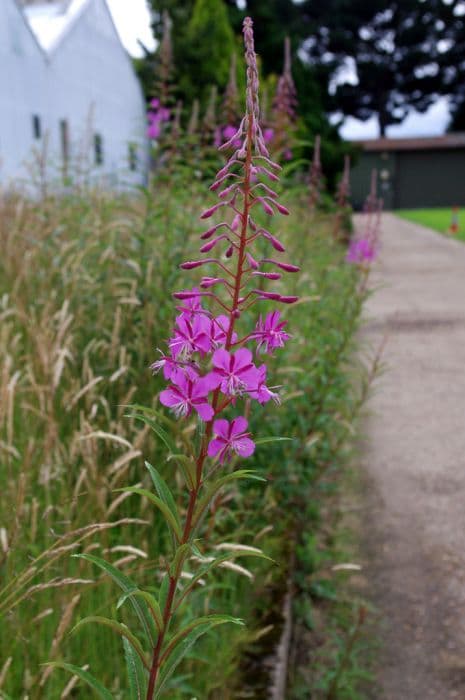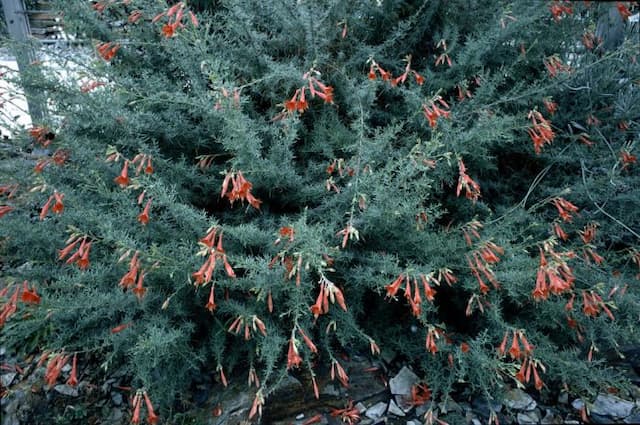Sundrops Oenothera fruticosa 'Fyrverkeri'

ABOUT
Oenothera fruticosa 'Fyrverkeri', widely known as the Sundrops, is an attractive plant noted for its striking, showy flowers and foliage. The Sundrops is a herbaceous perennial that is admired for its vibrant blooms and robust nature. The flowers of this particular cultivar of Sundrops are a warm, cheerful yellow, presenting a cup-shaped appearance that opens flat in full bloom. These radiant blooms are borne atop slender, red-tinged stems that provide a delightful contrast to the bright petals. The foliage of Sundrops adds to its overall charm, with lance-shaped leaves that are somewhat bushy, displaying a unique bluish-green color during the growing season. In some instances, the foliage may present a reddish tint, particularly on the edges, contributing to the plant's colorful display. The leaves of the Sundrops are arranged in a slightly spiraling fashion on the stems, giving the plant a full and lush look. With its prolific flowering habit, Sundrops is known to create an eye-catching display in the garden, attracting pollinators and admirers alike. The flowers of the Sundrops usually open in the late afternoon and remain open until the following morning, making it a delightful addition to any evening garden space. The plant has a tendency to spread, creating patches that offer a radiant burst of color, which further enhances the visual appeal of any planting area it graces. Its overall look is one of casual, wildflower-like beauty, bringing a sense of enchantment to the landscape.
About this plant
 Names
NamesFamily
Onagraceae
Synonyms
Narrowleaf Evening Primrose, Sundrops, Southern Sundrop, Narrow-Leaved Evening Primrose
Common names
Kneiffia fruticosa, Oenothera fruticosa, Oenothera tetragona, Xylopleurum fruticosum, Xylopleurum tetragonum.
 Toxicity
ToxicityTo humans
Oenothera fruticosa 'Fyrverkeri', commonly known as the Sundrops, is generally not considered toxic to humans. Therefore, accidental ingestion of parts of this plant typically does not cause serious harm. However, consuming any plant material may induce a reaction in individuals with specific allergies or sensitivities, and it is always advised to avoid eating any parts of ornamental plants due to the potential for gastrointestinal discomfort or other, less common, adverse reactions.
To pets
Sundrops or Oenothera fruticosa 'Fyrverkeri' is not known to be toxic to pets. There are typically no dangerous side effects associated with pets ingesting this plant, but as with humans, consumption of any plant material can potentially cause mild gastrointestinal upset in some animals. Close observation is recommended if a pet ingests this or any unfamiliar plant, and contacting a veterinarian is advisable if any concerning symptoms arise.
 Characteristics
CharacteristicsLife cycle
Perennials
Foliage type
Deciduous
Color of leaves
Green
Flower color
Yellow
Height
1-3 feet [30-91 cm]
Spread
1-2 feet [30-61 cm]
Plant type
Shrub
Hardiness zones
5
Native area
North America
Benefits
 General Benefits
General Benefits- Attracts pollinators: Oenothera fruticosa 'Fyrverkeri', commonly known as the Sundrops, is known to attract bees, butterflies, and other beneficial insects, thus enhancing pollination in gardens.
- Drought tolerance: Sundrops have a high tolerance for drought conditions, making them a resilient choice for arid and dry landscapes.
- Low maintenance: This plant requires minimal care once established, making it a convenient choice for gardeners with limited time.
- Fast growth: Sundrops grow relatively quickly, providing gardeners with a swift display of color and ground coverage.
- Evening blooms: The flowers of Sundrops typically open in the evening, adding a unique interest to the garden at dusk.
- Landscape uses: This plant is versatile, suitable for borders, rock gardens, wildflower meadows, and as ground cover.
- Extended blooming period: Sundrops offer a long blooming season, often from late spring through summer, providing a continuous display of color.
- Wildlife habitat: It provides habitat and food for certain wildlife species, contributing to the biodiversity of the area.
 Medical Properties
Medical PropertiesThis plant is not used for medical purposes.
 Air-purifying Qualities
Air-purifying QualitiesThis plant is not specifically known for air purifying qualities.
 Other Uses
Other Uses- Sundrops 'Fyrverkeri' can be used as a natural dye, with various plant parts yielding different colors depending on the mordant used.
- The plant’s fibrous stems may be utilized in traditional textiles, where they are processed and woven into fabric.
- The seed oil from Sundrops 'Fyrverkeri' can be used in low-grade industrial lubricants or as a potential ingredient in eco-friendly paints.
- While not fit for consumption, the seed pods can be used in artistic and craft projects due to their interesting shape and texture.
- Its strong root system can be employed in soil-erosion control projects, helping to stabilize banks and slopes.
- The dried flowers and stems are sometimes used in floral arrangements and potpourri mixes for their lasting color and form.
- Sundrops 'Fyrverkeri' can be a teaching tool in botanical and environmental education programs, demonstrating plant growth and pollinator attractions.
- The plants can sometimes be used as a living mulch to suppress weeds and retain soil moisture in garden beds.
- Biomass from Sundrops 'Fyrverkeri' could potentially be used in compost or as green manure, returning nutrients to the soil.
- The vibrant flowers can act as natural indicators of seasonal change in phenological studies, noting the timing of their blooming periods.
Interesting Facts
 Feng Shui
Feng ShuiThe Sundrops is not used in Feng Shui practice.
 Zodiac Sign Compitability
Zodiac Sign CompitabilityThe Sundrops is not used in astrology practice.
 Plant Symbolism
Plant Symbolism- Peace - Oenothera, commonly known as Sundrops, often symbolizes peace due to its calming presence and gentle appearance.
- Healing - Sundrops are also associated with healing, as many species of Oenothera have been used in traditional medicine.
- Resilience - This plant can thrive in challenging environments, representing resilience and adaptability.
 Water
WaterSundrops prefer even moisture and should be watered thoroughly when the top inch of soil feels dry to the touch. In general, water the plant with about 1 inch of water per week but adjust for rainfall accordingly. During dry spells or in particularly hot climates, you may need to water twice a week. Ensure adequate drainage as they do not like to sit in soggy soil. It's better to water in the morning to allow foliage to dry out during the day, reducing the risk of plant diseases.
 Light
LightSundrops thrive in full sun conditions where they can receive at least 6 to 8 hours of direct sunlight a day. They are best suited for open areas that are free from shade for most of the day, such as the edge of a garden or in a sunny border. Avoid planting them in shaded areas as it can impede their growth and bloom production.
 Temperature
TemperatureSundrops are hardy and can tolerate a range of temperatures, generally suitable for the plant zone they are grown in. They can survive in temperatures as low as 20°F but strive best in areas where the temperature stays between 60°F and 80°F. Extreme heat above 90°F may slow down flowering, while prolonged cold below the aforementioned minimum can damage the plant.
 Pruning
PruningPrune sundrops to maintain their shape and encourage bushier growth. Deadheading spent blooms will promote more flowers. The best time to prune sundrops is in late winter or early spring before new growth begins. Cut back the old foliage to about 2 to 3 inches above the ground. Pruning every year can also help prevent the center of the plant from dying out.
 Cleaning
CleaningAs needed
 Soil
SoilThe Sundrops, or Oenothera fruticosa 'Fyrverkeri', thrives best in a well-draining soil with a mix of loam, sand, and some organic matter. A slightly acidic to neutral pH of 5.5 to 7.0 suits it well. To improve drainage and fertility, incorporate compost or aged bark into the native soil.
 Repotting
RepottingSundrops plants, which typically have a robust growth habit, may not need frequent repotting. Generally, they should be repotted or divided every 2 to 3 years, or when the plant outgrows its current space, to maintain vigor.
 Humidity & Misting
Humidity & MistingThe Sundrops prefers average to low humidity levels, which is typical of most garden environments. It does not require any special humidity adjustments and will thrive in the natural outdoor humidity.
 Suitable locations
Suitable locationsIndoor
Provide bright light and well-draining soil for indoor Sundrops.
Outdoor
Plant in full sun with well-draining soil for outdoor Sundrops.
Hardiness zone
4-9 USDA
 Life cycle
Life cycleOenothera fruticosa 'Fyrverkeri', commonly known as the Sundrops, begins its life cycle when seeds germinate in spring, after which seedlings emerge and establish themselves with a rosette of leaves. As the plant matures, it develops a sturdy stem and a branching habit, sporting narrow, lance-shaped leaves. In early summer, Sundrops produces bright yellow, cup-shaped flowers that open during the day and attract pollinators, leading to the fertilization of flowers and the formation of seed capsules. After pollination, the plant sets seeds that are dispersed by wind, animals, or self-falling near the parent plant. In the fall, the plant begins to die back and enters dormancy during the winter months, conserving energy in the root system. With the return of warmer temperatures in spring, the cycle restarts as new growth emerges from the perennial rootstock.
 Propogation
PropogationPropogation time
Spring to early summer
The most popular method of propagating the plant known commonly as the Sundrops or Oenothera fruticosa 'Fyrverkeri' is through root division. This is typically done in the spring or autumn. To propagate by division, gently dig up the plant and carefully separate the root ball into smaller sections, ensuring that each new section has a part of the root system and several shoots. These can then be immediately replanted into a well-prepared soil enriched with organic matter. Plant divisions should be watered thoroughly after planting to reduce transplant shock and encourage root growth. It's an effective way to produce new plants that will be true to the parent plant, as seed propagation may result in genetic variability.









